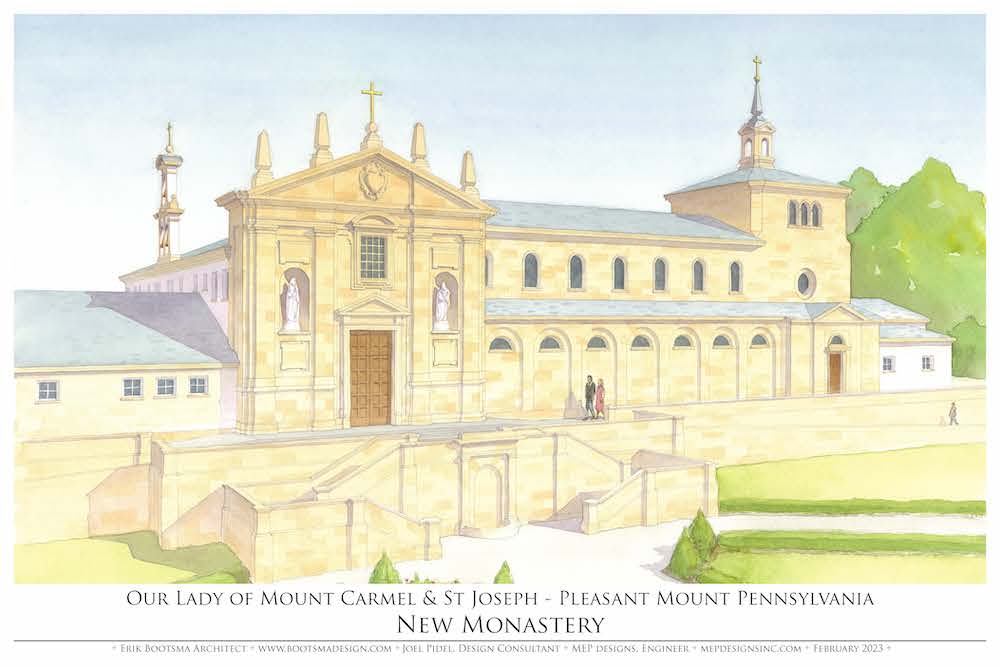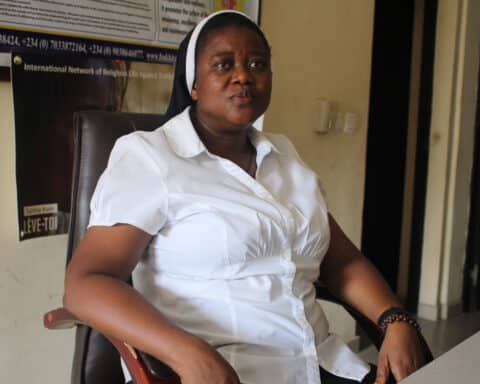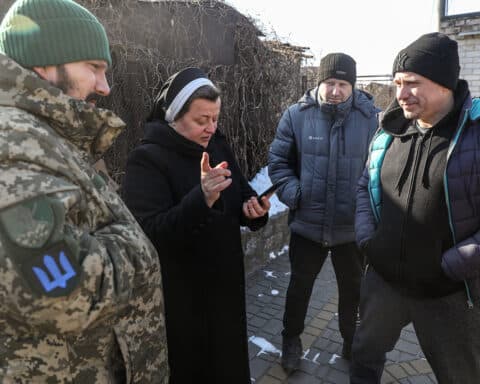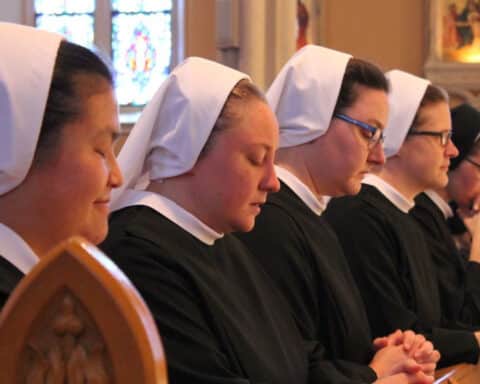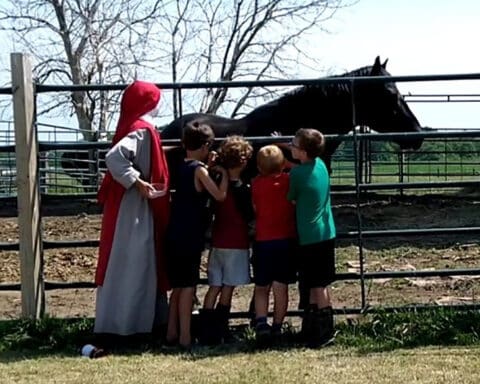When a small group of Carmelite nuns in Brooklyn was offered an expansive portion of land in Pennsylvania, they saw the gift as an answer to prayer — years of it.
“When the owner told us that his entire property had been consecrated to Our Lady, and that he had always sensed that it was going to be used for something holy, we felt that perhaps Jesus and Mary were pointing us to this spot for our new home,” Mother Ana Maria of Jesus, OCD, told Our Sunday Visitor.
The 10 cloistered nuns belonging to the Monastery of Our Lady of Mount Carmel and St. Joseph had been looking to leave New York City due to the noise and danger there, the prioress said. Even after preemptively relocating to Pennsylvania in January, they learned that their monastery had been broken into several times.
The new land meant new hope. When they visited the 13-acre property in Pleasant Mount — a three-hour drive north from Philadelphia — the nuns embraced the peaceful solitude of the countryside and decided it was the perfect site for a contemplative monastery.
A classical monastery
After receiving a warm welcome from the local bishop, Bishop Joseph C. Bambera of Scranton, the Carmelite nuns contacted Rome for permission to transfer. In the meantime, they began planning the monastery.
“We contacted an architect friend of our community, Joel Pidel, a relative of one of the sisters who is a devout Catholic and who is very much interested in promoting Catholic faith and culture through classic, traditional church architecture,” Mother Ana Maria described.
He agreed to design the monastery in his free time.
Together, they decided to create a traditional Spanish monastery. They wanted it to resemble, as closely as possible, the monasteries born in the heart of the Carmelite reform in Spain since the time of St. Teresa of Ávila, Mother Ana Maria explained.
She emphasized the importance of the architecture on her community’s lifestyle.
The design, Mother Ana Maria said, “would be both conducive to our life of prayer and silence, as well as to the practical aspects of our life, such as manual labor, and which would also be a structure of austere beauty to lift the heart and mind to God.”
The massive project will include a monastic enclosure for 24 nuns, a chapel holding up to 148 visitors, barns, gardens, a cemetery and facilities for baking Communion wafers. They are also planning separate houses for guests, priests and the porter.
‘A place, consecrated and set apart’
After the nuns obtained permission from Rome, the fundraising and work began. They had help.
“We were moved to see that everyone who heard about the monastery, wanted to contribute in some way, and all of those who have joined the team responsible for building the monastery are devout Catholics, not so much interested in getting a job done as in contributing to a work of faith and love for God’s glory,” Mother Ana Maria said.
“This coincides with the main apostolate of the Discalced Carmelite Nuns, and the purpose of the future monastery,” she added, which is “to create a place, consecrated and set apart, where we can assist the Church and her pastors by our life of constant prayer and penance, as well as intercede for the conversion of sinners and the salvation of souls.”
The monastery, she said, will not only benefit the religious but also the laity.
“[O]ur greatest joy will be to see that the new monastery can also be a place, a refuge and a sanctuary, as it were, where our beloved priests and faithful can spend time in prayer, in the shadow of Carmel, partake in the sacred liturgy … be encouraged by our prayers and also share in our mission of interceding for the Body of Christ and for the salvation of souls.”
A house for God
The chapel, Mother Ana Maria said, will serve as the focal point of the monastery.
“While our holy mother St. Teresa [of Ávila] wanted her Carmel’s to maintain an interior austerity and poverty, she desired that the chapel be adorned as beautifully as possible, to honor Our Lord’s real presence in the Blessed Sacrament,” she explained. “This is reflected in the design of the chapel of the new monastery, following Renaissance, early Baroque and Carmelite architecture, as well as in the arrangement of the chapel for the traditional liturgy, which is offered in our monastery.”
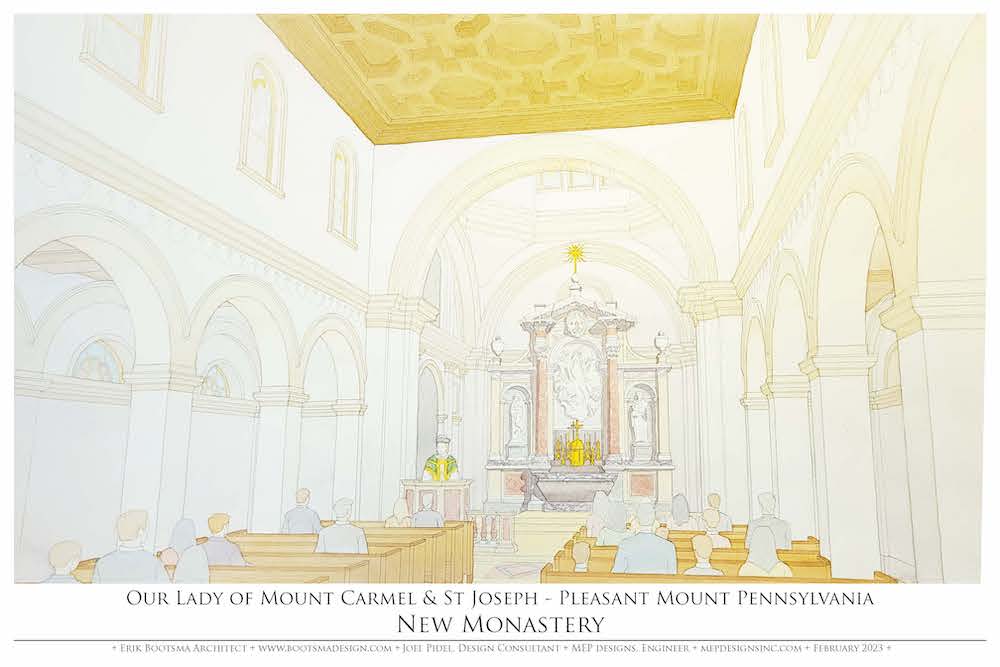
The monastery’s website describes the nave, or the central part of the church, which it says will include square piers or columns supporting arched openings, stained glass windows, stone floors and a coffered oak ceiling. The sanctuary will feature a Baroque reredos (an ornamental screen covering the wall behind the altar) and a dome serving as a baldachin or canopy above the altar.
Baking bread
The new monastery will also provide a place to bake bread. The nuns from Brooklyn started making Communion hosts in 2007 as a way to support themselves. Their work quickly grew.
“We placed our host baking under the patronage of St. Joseph and called our work, St. Joseph’s Altar Breads,” Mother Ana Maria said. “By 2023, shortly before we moved, St. Joseph’s Altar Breads had grown so much that we were sending hosts to about 250 parishes all over the country and baking around 6 million hosts per year.”
She stressed the significance of this service.
“It has been a great blessing for us to be associated so intimately with the Holy Sacrifice of the Mass by making the bread destined to become the body of Christ, and we hope to be able to continue this beautiful work in the future, once the monastery is built,” she said.
From Joseph to Mary
As in Brooklyn, the new classical monastery in rural Pennsylvania will be called the “Monastery of Our Lady of Mount Carmel and St. Joseph.” The land comes from Joseph Grady, the founder of My Jesus Mercy Ministries, who donated 13 acres of his property, which he calls “Mary’s Land.”
So far, Mother Ana Maria said, they have received around $2 million of the $25 million needed for the monastery. If God provides the funds through the generosity of the faithful, she said, the contractor estimates that the construction will take three to five years.
“When we first began planning the monastery, we did not envision how extensive the project would be, nor how expensive!” she commented. “However, our team of architects and contractors have assured us that building the monastery using the best materials possible, like stone, although it would take longer and entail greater expense, would result in a structure that would last for generations to come.”
A way to help
For Catholics interested in supporting the new monastery, Mother Ana Maria asked for prayers and help with donations (which can be submitted either online or by mail) and spreading the word.
“[W]e beg everyone who reads about it to pray that the monastery might be built for God’s glory and the salvation of souls, and especially include this intention in their daily Rosary,” she requested.
“We also ask the faithful to consider contributing to the monastery building project,” she concluded. “If a lot of people contribute whatever they can, even if they feel that it is not much, little by little, the monastery will be built.”
Katie Yoder is a contributing editor for Our Sunday Visitor.

